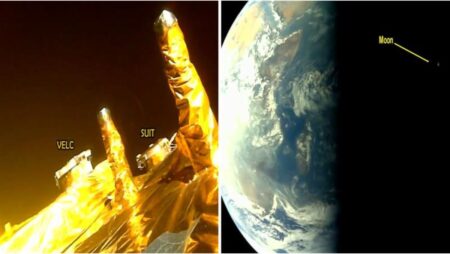After hearing the devastating news that the Chandrayaan SSLV mission had been unsuccessful, there was a glimmer of optimism when ISRO’s Chandrayaan-2 made a significant scientific finding. It has been discovered that there is a plasma density in the moon’s ionosphere, which opens up new possibilities in terms of comprehending the environment on the dark side of the moon.
Millions of people were devastated when it became clear that the first test flight of ISRO’s Small Satellite Launch Vehicle (SSLV) would not be successful in fulfilling its objective. Because the SSLV was unable to successfully deliver two satellites into orbit, those spacecraft are now useless
A necessary read: What is the ISRO Solid Rocket Booster (SSLV), which is India’s smallest launch vehicle, and why do we require it
However, right on the heels of the disheartening information came a glimmer of optimism in the form of a scientific discovery made by ISRO’s Chandrayaan-2. The Chandrayaan-2 spacecraft discovered that the ionosphere of the moon has a density of the plasma.
What has the Chandrayaan-2 mission discovered?
ISRO’s homegrown spacecraft was sent into lunar orbit in July 2019, carrying many payloads. One of these payloads was called Dual Frequency Radio Science (DFRS), and its mission was to investigate the ionosphere surrounding the moon.
The most recent discovery would not have been possible without the contribution of the DFRS. Using the technology, Chandrayaan-2 discovered that the plasma density in the wake region of the moon’s ionosphere is at least one order of magnitude more than what is present on the day side of the moon.
The discovery paves the way for new opportunities to better comprehend the plasma environment on the dark side of the moon.
In the wake zone of the moon’s ionosphere, the plasma density has been measured to be 104 per cubic centimeter, which is at least an order of magnitude higher than the density found on the moon’s day side. The observations were carried out with DFRS.
ISRO stated that even though neither the solar radiation nor the solar wind interacts directly with the available neutral particles in the wake region, plasma is still being generated. “In the wake region, neither the solar radiation nor the solar wind interacts directly with the available neutral particles,”
The Defense Frequency Reference System (DFRS) makes use of two coherent transmissions in the radio frequency bands S-band (2240 MHz) and X-band (8496 MHz). These are sent from the Chandrayaan-2 orbiter and received by the ground station in Byalalu, which is located in Bengaluru. The purpose of this is to investigate the plasma environment of the moon using the radio occultation (RO) technique.
According to ISRO, the use of simultaneous measurements by two coherent radio signals helps offset the effect of Earth’s atmosphere and any uncertainties caused by numerous sources while the experiments are being conducted.
On a total of four separate times, a total of twelve of these radio occultation tests were carried out using the campaign mode.
These findings were recently presented in a letter that was published in the Monthly Notices of the Royal Astronomical Society-Letter magazine.
“These observations are one of a kind due to the fact that they reveal boosts in the iEDPs after sunset in comparison to dayside, as was observed by earlier missions. According to the conclusion of the research study, “these data further validate recent predictions from the theoretical model for the lunar ionosphere.
In addition to this, the specialists observed that argon and neon are the predominant ions in the wake zone. These molecular ions of carbon dioxide and water have a relatively long lifetime compared to the molecular ions that predominate in other locations
“Numerical simulations of the dark side of plasma environment using a 3-dimensional Lunar Ionospheric Model (3D-LIM) developed at SPL that the production of ions by charge exchange reactions may play a pivotal role in producing a significantly large plasma density in the Lunar wake region, which can sustain for a longer period,” the Indian Space Research Organization (ISRO) said in a statement. “These simulations were carried out using a 3-dimensional Lunar Ionospheric













